Abstract
In this paper, a novel auxetic structure with rotating squares with holes is investigated. The unit cell of the structure consists of four units in the shape of a square with cut corners and holes. Finally, the structure represents a kind of modified auxetic structure made of rotating squares with holes or sheets of material with regularly arranged diamond and square cuts. Effective and dynamic properties of these structures depend on geometrical properties of the structure. The structures are characterized by an effective Poisson’s ratio from negative to positive values (from about minus one to about plus one). Numerical analysis is made for different geometrical features of the unit cells. The simulations enabled the determination of the dynamic characteristic of the analyzed structures using vibration transmission loss, transmissibility, and mechanical impedance. Numerical calculations were conducted using the finite element method. In the analyzed cases of cellular auxetic structures, a linear elasticity model of the material is assumed. The dynamic characteristic of modified rotating square structures is strongly dependent not only on frequency. The dynamic behavior could also be enhanced by adjusting the geometric parameter of the structure. Auxetic and non-auxetic structures show different static and dynamic properties. The dynamic properties of the analyzed structures were examined in order to determine the frequency ranges of dynamic loads for which the values of mechanical impedance and transmissibility are appropriate.
1. Introduction
Composite materials can have different physical properties combined. The interest in this scientific issue is due to the possibility of applying the results obtained in practice. Due to these facts, some terminology and neologisms have been proposed and collected by Lakes in the book [1] concerning the properties of heterogeneous materials: smart materials (the properties can be altered or controlled by field variable stimuli); bio-mimetic (the design imitates structures observed in biological materials); bio-inspired (the design process is influenced by biological materials); auxetic materials (have a negative Poisson’s ratio); metamaterials (allow unusual properties); architected materials (multiphase materials or cellular materials that are controlled and optimized to achieve specific functions or properties); multifunctional materials (serve multiple roles in a practical application).
Saint-Venant (1848) seems to be the first who suggested that Poisson’s ratio might be negative in anisotropic solids and achieve values greater than 1/2 [2,3]. The histories of Poisson’s ratio (PR) and negative Poisson’s ratio (NPR) are presented in the first chapter of Lim’s book [2]. Materials that become wider when they are stretched and become thinner when compressed are characterized by a negative Poisson’s ratio and are called auxetic materials (auxetics).
Auxetics are examples of metamaterials with negative properties [4]. The terms “auxetic” and “auxetic materials” were introduced by Evans et al. in 1991 [5]. The Greek word “auxeticos” is defined as “that which tends to increase”.
A number of review papers and books have been written concerning auxetic materials. These include the books by Lim, Lakes [1,2,6], and the works of many researchers [7,8,9,10,11,12,13,14]. Nevertheless, they are not limited to them.
The range of research topics on auxetic materials increases exponentially, resulting in a large number of publications over the past decade. Hence, interested readers are referred, but not limited, to papers in the area of auxetics written by Wojciechowski et al. [15,16], Novak et al. [17,18,19], Lim [20], Strek et al. [21,22,23], Shepard et al. [24], Jopek et al. [25,26], Michalski et al. [27,28,29], Burlaga et al. [30], and Zhang et al. [31].
Due to the mechanism of displacements and deformations in the auxetic structure, we divide them into the following types: reentrant type; chiral type; and rotating units. In particular, Saxena et al. [9] summarized different types of auxetic structures and models as
- (1)
- re-entrant type (2D re-entrant, 2D re-entrant triangular, 3D re-entrant, double arrowhead);
- (2)
- rotating polygons (squares, rectangles, rhombi, parallelograms, triangles, tetrahedral);
- (3)
- chiral type (chiral circular, rotachiral, 3D chiral, anti-chiral);
- (4)
- perforated sheets (perpendicularly oriented cuts, randomly oriented cuts, diamond perforations, star perforations, 2D sheet containing holes);
- (5)
- crumpled sheets (aluminum thin foils, graphene sheet);
- (6)
- other (nodule fibril model, hexatruss, egg rack structure, missing rib, generalized tethered nodule, entangled single wire auxetic, grooved block of metal, hard discs).
Teik-Cheng Lim presented in his works [6,32] the identification of structures due to the mechanical model of operation. This analysis identified five categories of auxetic models. The models of the auxetic structure in each category are similar to each other. The author distinguished the following categories of structures in which unit cells are characterized by (1) single periodicity, (2) double periodicity, (3) synchronized direction of rotation of their rotating units, (4) random rotation and (5) no rotation.
Auxetic structures with rotating units were presented by Grima and Evans [33], where rigid rectangular and triangular cells were connected together at selected vertices by hinges. The later papers on this topic of auxetics made of rotating units were published by researchers from Malta [14,34,35,36,37] and Slovenia [38]. Grima-Cornish et al. [14] described the role of rotating rigid units in generating negative thermal expansion (NTE) and negative compressibility (NC) in auxetic materials with a mechanism made of rotating units (RUM) or quasi-RUM (qRUM). Han et al. [39] investigated the influence of the hole radius in the design domain of an auxetic structure with rotating units on the mechanical properties of the structure and the importance of the materials in different parts of the design domain to the overall stability of the structure.
There are a lot of properties important to auxetic materials. These properties include indentation resistance, synclastic, shear properties, fracture toughness, first law of thermodynamics for auxetics, wave propagation/vibration transmission, acoustic absorption, variable permeability concomitantly with a high shear modulus relative to the bulk modulus, negative compressibility [2,6,8,40,41].
Specific applications of auxetic materials and structures require a lot of further development. Nevertheless, a review of the literature already shows the great potential for their application in various fields. One can mention here, for example, the following applications of auxetics: medical and biomedical applications (e.g., stents, dilators for opening the cavity of an artery, coronary angioplasty and related procedures, smart bandages, smart filters); sports applications (sport helmets, protection against extreme weather during outdoor/adventure sports), molecular sieves and filters and defouling applications; displacement amplifiers; auxetic cushions in seats; auxetic springs; acoustic-to-electrical energy conversion; electromagnetic applications in antennas and reflectors; applications in fabrics, garments, and fashion apparel; fabrication of 3D auxetic fabric; auxetic shape memory alloys; footwear and articles of apparel; etc. One can find more details about applications of auxetic materials and structures in previous articles [7,8,9,41,42,43].
The study of vibrations is important from the point of view of the analysis of materials, structures [44,45,46], continuous systems with constraints, and controlled systems or oscillators [47,48]. The vibrations imply cyclical stresses, so fatigue failure is inevitable. Teik-Cheng Lim presented and discussed advanced issues concerning vibration damping, damping of acoustic vibration, and auxetic solids and structures [2]. Other authors and researchers also investigated a lot of properties of auxetic materials and structures (better vibration or acoustic properties compared to classic materials with positive Poisson’s ratios, impact energy absorption).
Their dynamic behavior has not been widely studied. In the study [44], the influence of two features of the lattice structure (the strut diameter and the mass attached to the sample) on the obtained frequency response function was evaluated. The effect of geometrical parameters on the dynamic response of the structure was also analyzed in the studies [45,46]. It was proved that the structures with negative Poisson’s ratios could achieve a wider bandwidth and a lower frequency bandgap than structures with positive Poisson’s ratios. According to Tao et al. [46], the bandwidth increases about 15.1% compared to a structure with a positive Poisson’s ratio. The parametric study was also presented in the paper [45]. It was proved that the adjustment of geometric features of a novel lightweight bidirectional re-entrant lattice metamaterial enabled changing the broad bandgaps in the low-frequency range. Strek et al. analyzed the dynamic response of a three-layered sandwich beam with a metal foam core. The study showed that the Poisson’s ratio of the foam core influences the obtained value of the average mechanical impedance of the sandwich beam. It observed that the lower the values of Poisson’s ratios, the higher the values of the resonance frequencies [23].
Since 1987, when Lakes manufactured the first auxetic re-entrant foam structure, we have observed an increase in research in auxetic materials and structures. However, there are still many important limitations and properties that must be studied before their real-life implementations. The challenges to be solved include the static and dynamic properties of auxetics. Extensive studies have been conducted analyzing rotating rigid units and their role in generating auxetic behavior in different classes of materials, such as foams, silicates and zeolites. The potential applications of auxetics include, but are not limited to, biomedical devices (e.g., novel stent design [49,50,51]), sport applications [11], military and industrial devices (e.g., explosion protection and blast response structures [29], energy absorption structures [17], sandwich panels [52]). In this paper, the dynamic properties of auxetic and non-auxetic structures are investigated. Structures with effective PRs from negative to positive values are investigated. The effective PR value depends on the geometrical properties of the structure and does not depend on the component material. The structures represent kinds of modified auxetic structures made of rotating squares with holes or sheets of material with regularly arranged diamond and square cuts.
Numerical analysis was made for different geometrical features of the unit cells. The simulations enabled the determination of dynamic characteristics of the analyzed structures using mechanical impedance (Z), transmissibility (vibration transmission, T), and vibration transmission loss (VTL). The basic dynamic properties of the analyzed structure were examined in order to determine the frequency ranges of dynamic loads for which the values of mechanical impedance and transmissibility were appropriate. In the case of better/greater damping of vibration, these are frequency ranges for which T takes negative values. Whereas, when we want to give the structure with a lower force the set vibration velocities, these are the frequency ranges for which Z is small.
Numerical calculations were conducted using the finite element method. In the analyzed cases of cellular auxetic structures, it is assumed that a linear elasticity model of material is used in cellular structure. The unit cells of the structures analyzed in this paper can be used as the main build element of bigger and more complex structures such as stents or cores of sandwich panels. Although in this paper 2D plane stress models of 3D solid structures are studied, the full 3D structures with rotating squares with holes can be used in real-life applications.
Moreover, the presented method of analysis of static and dynamic mechanical parameters of structures can be used in the analysis of 3D models of solids and structures. Based on the results of testing the static (effective Poisson’s ratio, Young’s modulus) and dynamic (mechanical impedance, vibration transmissibility) mechanical properties of representative samples of cellular materials (unit cells), we can use them in the construction of more complex materials and structures. An example of such constructions are sandwich panels, the core of which may be materials made of periodic unit cells, which were analyzed in this work. The results of the work carried out so far indicate very wide possibilities for their use in mechanical engineering, biomedical, automotive, military and building constructions.
2. Mathematical Model-Governing Equation
2.1. Linear Elasticity Equations
This section considers the equations which govern the motion of elastic structures experiencing small deformations, the determination of effective mechanical properties (Poisson’s ratio, Young’s modulus), and dynamic properties (mechanical impedance, vibration transmission loss or transmissibility).
The Navier-Cauchy equation of motion describes elastodynamics, and we can write this equation in displacement formulation as:
where ρ is the density, u is the vector of displacements, , is the stress tensor, is the volume force vector.
We can represent the balance of forces in three directions in the following form:
The total stress in Hooke’s law (constitutive equation, relation between stresses and deformations) is:
and the elastic strain tensor is:
In the case of the isotropic linear material, the elasticity matrix becomes as follows:
In terms of Lamé parameters λ and μ, the elasticity matrix can be written as:
The constitutive equation for a linear elastic isotropic material can be described as:
where is the identity matrix.
In this case, Navier’s equation of motion for the linear elastic isotropic material and with zero volume force () can be written as:
According to the harmonic displacement of the solid, the equation of harmonic motion with the assumed linear-elastic model of the material meets the formula:
where µ, λ are Lamé constants.
The loss factor () is the ratio of the average power loss to the peak load loss over the time interval that the load acts on the system [53]:
In the case of analyzing two-dimensional plane problems, the basic equations of elasticity can be simplified due to the made assumptions (some strain or stress components are by definition equal to zero), in relation to the equations describing three-dimensional spatial problems.
There are two main 2D models of plane solid mechanics problems [54]:
- plane stress—the load acts in a plane, and the thickness of the structure is constant and appropriately small in relation to other dimensions of the structure (appropriate thinness);
- plane strain—a constant load acts along the entire length of the structure (large enough), and its cross-section is constant over the entire length of its thickness.
For the plane stress, all stress components in the third direction (normal and shear) perpendicular to x–y plane are assumed zero. In this case, the elasticity matrix becomes:
Substitution of the elastic matrix for plane stress in the equilibrium equation gives Navier’s equation in terms of displacements as follows:
where is the shear modulus. The plane stress model of solid mechanics is used in this paper.
2.2. Effective Mechanical Properties of the Structure
The effective Poisson’s ratio can be calculated using the following formula:
where and are average strains in a transverse and longitudinal direction, respectively. Longitudinal direction is the direction of the applied load. The average strains can be calculated using:
where and are the original dimension of the sample and the average change of the length in i-th direction, respectively.
The effective Young’s modulus can be calculated using the following formula [55]:
where is the average strain, is the average cross-section area in i-th direction, is a force applied in i-th direction, and is the wrapping volume of the sample when the thickness of 2D sample is th.
The average dimensions of the sample in x and y directions can be calculated using:
respectively.
The values and are average values of the second component () of displacement vector () on the right (RB) and left (LB) boundaries of the sample:
The values and are average values of the second component () of displacement vector () on the top (TB) and bottom (BB) boundaries of the sample:
2.3. Dynamic Properties of the Structure
The dynamic reaction of the structure to the mechanical vibrations acting on it can be divided into two categories. The first category, “to the structure”, defines the dependence of the motion of the structure as a function of frequency, expressed as a function of the mechanical impedance of the driving point. The second category, “through structure” response function, is defined as the vibration transmission from the boundary with the applied load to the free opposite boundary of the structure.
The frequency domain analysis enabled the computation of the response of a model subjected to harmonic excitation for the specified range of frequencies. The dynamic characteristic was defined using mechanical impedance (Z), vibration transmission loss (VTL), and transmissibility (T). Mechanical impedance (Z) is defined as the ratio of applied force (F0) and the velocity response (v0), which strongly depends on frequency [56,57]. In order to evaluate the dynamic properties of the whole domain (Ω), the average mechanical impedance was analyzed. It is expressed using the following formula [23]:
In this study, transmissibility (T) is evaluated in terms of displacements. The displacement transmissibility, expressed in dB, is defined as the ratio between the amplitude of the response and the excitation in the respective direction [58]. It is evaluated using the given formula:
where indicates the amplitude of response and is the amplitude of the harmonic excitation in the indicated i-th direction .
Another essential parameter which enables determination of the dynamic characteristic of analyzed structures is vibration transmission loss (VTL). This parameter allows the evaluation of the isolation properties of the structures. It indicates the frequency range in which the structure does not transmit vibration [59,60]. It is expressed using the following formula:
As is well-noted, the vibration transmission loss is the reverse of transmissibility.
3. Models and Methods
3.1. Geometrical Model
The analyzed structure consists of a unit cell which is based on rotating squares. The single unit cell consists of four squares with holes of different sizes. The structure is created by cutting four triangles from the surface of a single square.
In the model, the four geometric parameters are determined. All parameters are defined as the ratio of the variable dimension to the basic square edge length (). The first dimension (d1) is defined as one of the edges of the cut-out rectangle (Figure 1). The second parameter (d2) is calculated based on the ratio d1. It was assumed that the area of cut-out triangles is constant (Figure 2). The parameter d1 was expressed as the ratio between the distance l1 and the length of the square edge. It was studied in the range of 0.30–0.65 (Figure 3 and Figure 4).
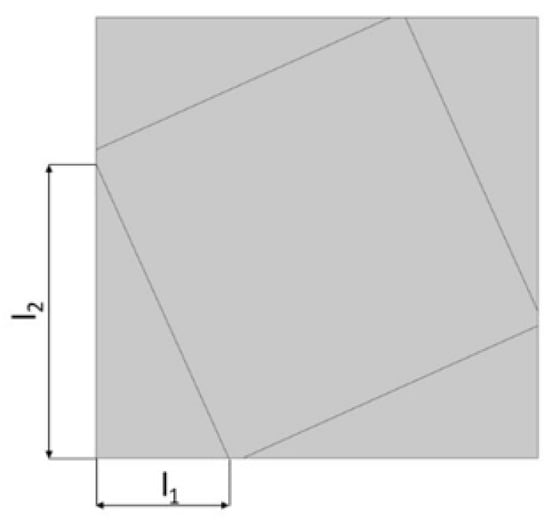
Figure 1.
The first stage of the process of obtaining the cell: defining the dimensions of the cut-out triangle.
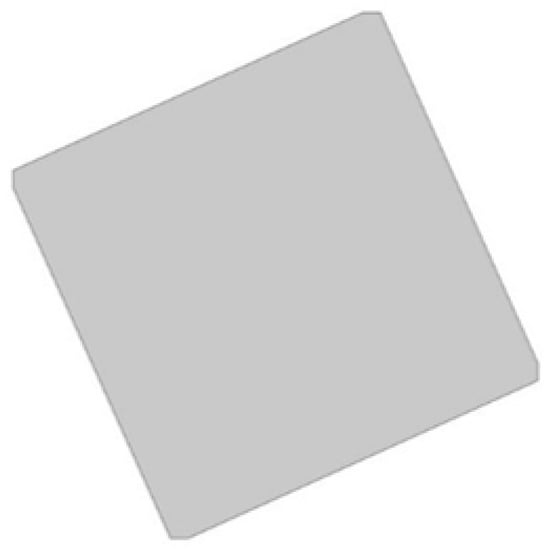
Figure 2.
The results of performed process of obtaining the cell.
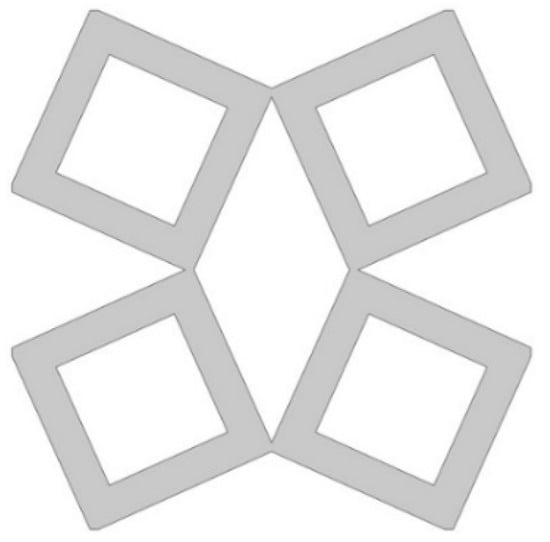
Figure 3.
The obtained unit cell for d1 = 0.30.
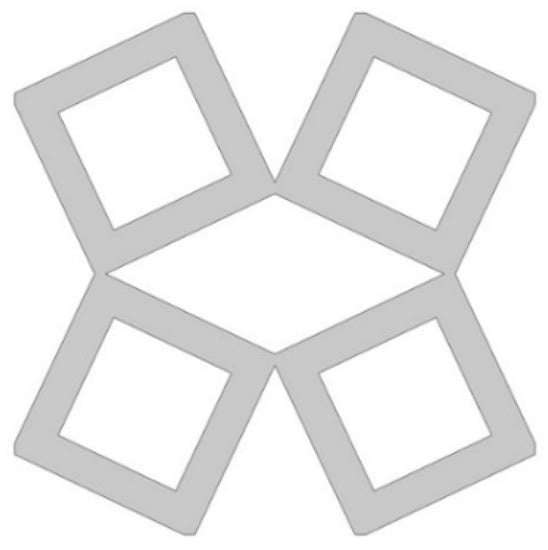
Figure 4.
The obtained unit cell for d1 = 0.65.
The next essential geometric feature of the structure is the distance between the outer square and the inner square (w1). The parametrized dimension is shown in Figure 5. The inner square is cut from the surface of the base shape. The w1 parameter was analyzed in the range of 0.15–0.45 (Figure 6 and Figure 7).
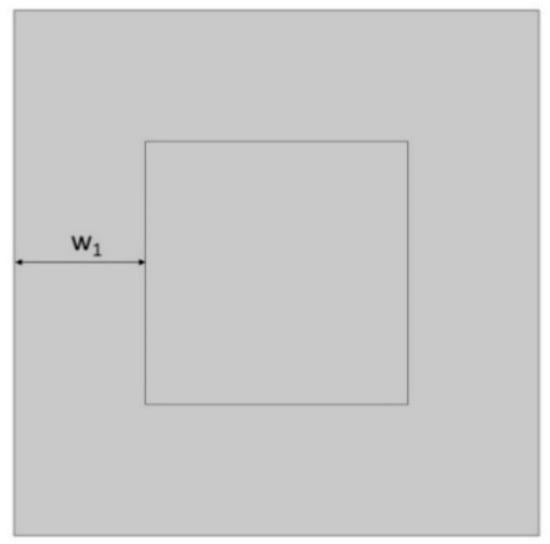
Figure 5.
Distance between the outer and inner square in the unit.
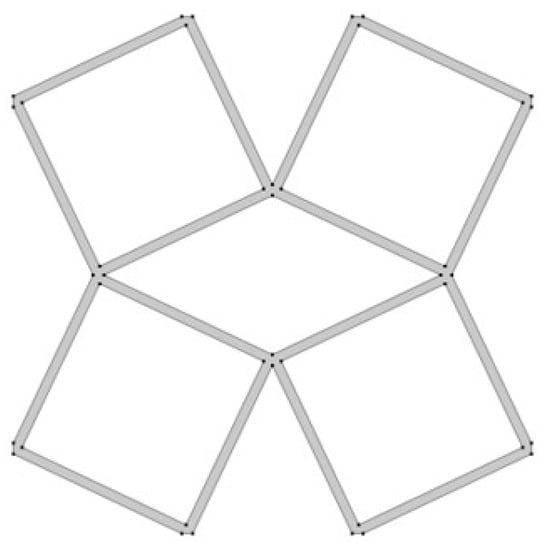
Figure 6.
The obtained unit cell for w1 = 0.15.
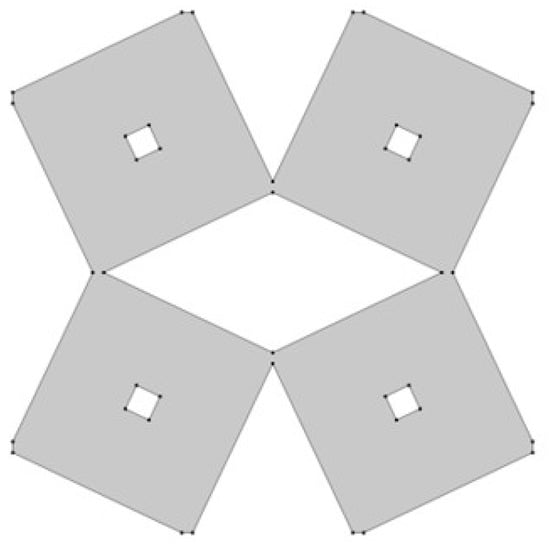
Figure 7.
The obtained unit cell for w1 = 0.45.
The last analyzed parameter was the radius of the fillet in the middle part of a unit cell. The parameter has a value from 0 to 0.15 (Figure 8, Figure 9 and Figure 10).
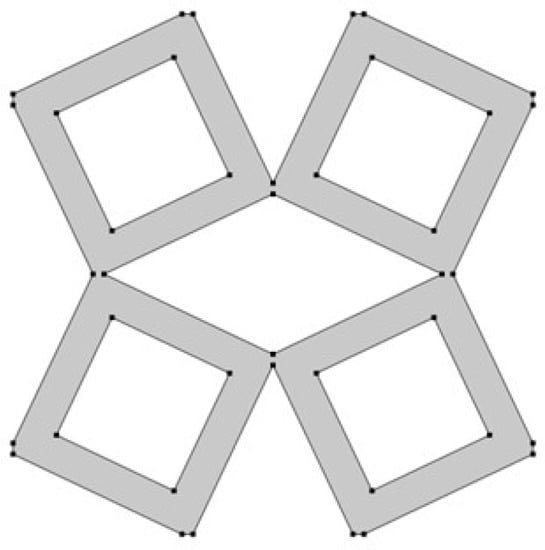
Figure 8.
The obtained unit cell for fillet radius = 0.
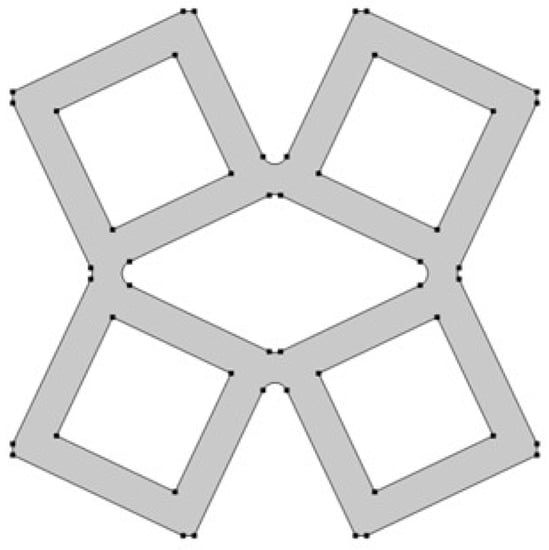
Figure 9.
The obtained unit cell for fillet radius = 0.05.
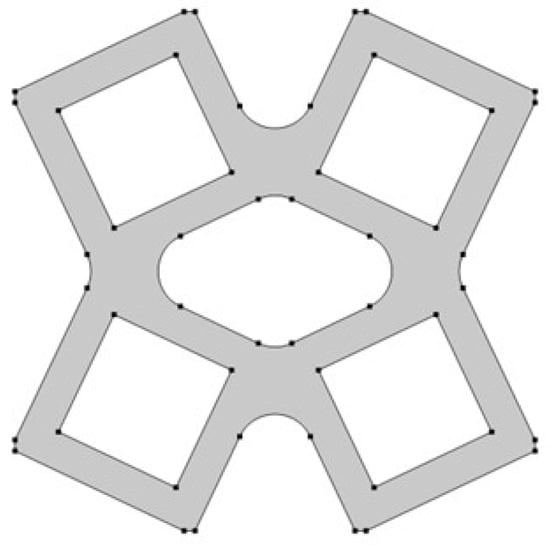
Figure 10.
The obtained unit cell for fillet radius = 0.15.
All analyzed structures have dimensions: , where m.
Designation and definition of boundaries of analyzed samples:
- right boundary (RB): and ;
- left boundary (LB): and ;
- bottom boundary (BB): and ;
- top boundary (TB): and .
3.2. Finite Element Model
During the conducted analysis, two load cases were considered. In the first load scenario, in order to evaluate the effective value of Poisson’s ratio and Young’s modulus, on the edges indicated in Figure 6, roller constraint boundary conditions were applied, which is equivalent to a condition of symmetry. It resulted in zero displacements in the perpendicular direction to the indicated edge. Nevertheless, the boundary can move in a tangential direction. In the second case, the unit cells were harmonically loaded on the top or bottom boundaries.
Boundary conditions (BC), see Figure 11 and Figure 12, were applied to analyze the mechanical properties of structures when the load applied at the upper (top) boundary is directed vertically in the y-direction:
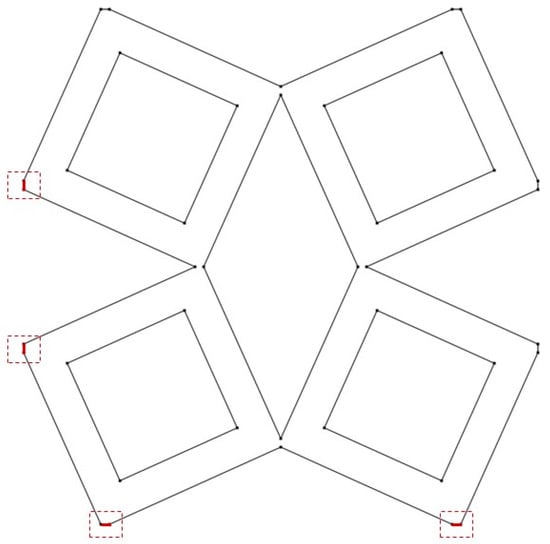
Figure 11.
The edges constraint using roller boundary condition.
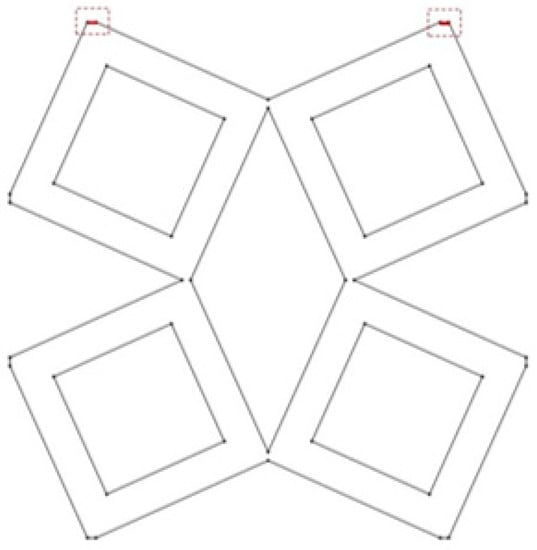
Figure 12.
Considered load scenario for evaluation of effective structure properties. Free boundary condition is applied for the remaining boundaries.
- boundary (RB): free BC;
- boundary (LB): roller (symmetry) BC: , where is the normal unit vector to the boundary;
- boundary (BB): roller (symmetry) BC:,
- boundary (TB): prescribed displacement: ; or
- boundary (TB): applied force: , and , where is the length of boundary TB.
Boundary conditions (BC), see Figure 13, were applied to analyze the dynamic properties of structures when the load applied at the bottom boundary is directed vertically in the y-direction:
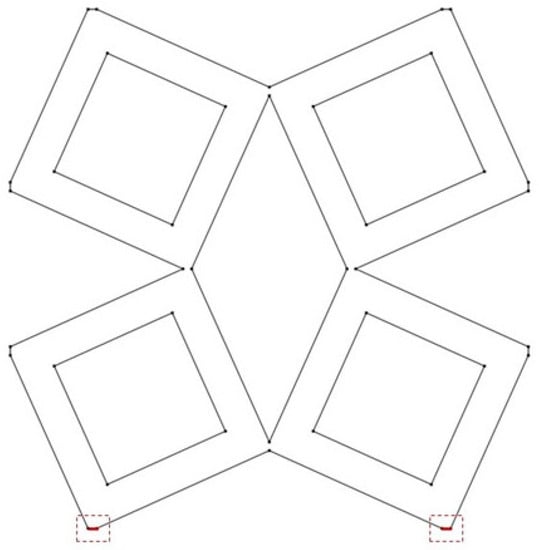
Figure 13.
Considered load scenario for evaluation the dynamic characteristic of the structure. Free boundary condition is applied for the remaining boundaries.
- boundary (RB): free BC;
- boundary (LB): free BC;
- boundary (TB): free BC;
- boundary (BB): harmonic excitation prescribed displacement BC: ; or
- boundary (BB): harmonic excitation force BC:, and .
The influence of geometrical features was investigated using the finite elements method (FEM) [61]. The analyses were conducted in Comsol Multiphysics software with the MUMPS solver [53]. The geometry was discretized using triangular elements. Due to the computational cost, the two-dimensional model was applied. The 2D physics interface for plane stress assumes that the load is constant throughout the material’s thickness (th). Second order Lagrangian polynomials were used as shape functions for finite triangle elements. Contact without friction between structure elements was assumed.
Convergence of the simulation was tested both for coarser and finer mesh, which consists of almost 9350 elements. The obtained relative differences between results were below 5%.
4. Numerical Results
4.1. Effective Mechanical Properties of the Analyzed Structure
The numerical experiments were conducted in order to analyze the mechanical properties of the proposed auxetics structure. The influence of geometric features on the Poisson’s ratio and Young’s modulus was evaluated. All numerical calculations were conducted using the finite element method and a plane stress solid mechanics model with a linear elasticity model of the material.
The applied material is structural steel (Table 1).

Table 1.
Material properties of structural steel.
When calculating the value of PReff, was defined as the prescribed compression displacement in the y-direction applied on the top boundary. The value of the prescribed displacement was evaluated using the following formula:
The value of the applied force in every conducted simulation (with the exception of analyses that allowed the determination of PReff) was equal to 100 N, and the force acted parallel to the y-axis.
The area of each cut triangle (see Figure 1) was constantly equal to .1 for each parameter . Real dimensions represented by the parameters can be calculated using formula:
where is assumed to equal to 0.1 m. The thickness of the structure was equal to th = 0.01 m. The range of values of the analyzed parameters is shown in Table 2.

Table 2.
Ranges of analyzed values of parameters.
The Poisson’s ratio (υ) is defined as the ratio of the negative transverse strain and the axial strain in the direction of the applied force. In this study, the obtained value of the effective Poisson’s ratio (Equation (13)) was in the range of −1 to 1 (Figure 14). It was noticed that the value of υeff strongly depends on the geometric features of the structures. It was observed that the higher the value of w1, the lower the value of υeff, and the structure was more auxetic. For w1 values equal to 0.15 in all of the analyzed cases, the structures were non-auxetic. For this instance, the value of υeff was less influenced by changes in the d1 parameter. It was also observed that the higher the value of w1, the wider the range of d1 in which the structure is auxetic. The maximum υeff occurred for a d1 equal to about 0.45.
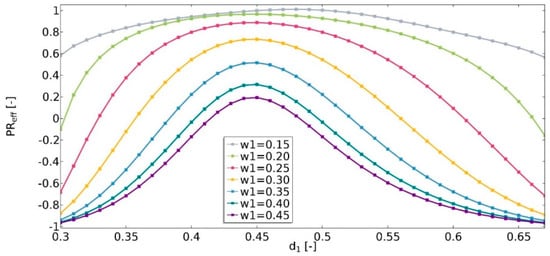
Figure 14.
The influence of geometric features on the value of effective Poisson’s ratio.
For the structure in which no auxetic effect was observed (w1 = 0.15), a significant decrease in the value of the effective Young’s modulus (Equation (15)) was observed (Eeff). The ratio Eff/Es was no higher than 0.01 (Figure 15). The slight fluctuations of the values with the change of the d1 parameter were noticed. In the case of structures which obtained negative Poisson’s ratios, properties of the structure changed significantly with the increase in the value of d1. For the case in which υeff reached a value approximately equal to 0 (w1 = 0.45, d1 = 0.45), the ratio Eff/Es reached the maximum. Eeff for this parameter set was about 0.46 times lower than the value of the material’s Young’s modulus. The d1 variable also influenced the obtained structure’s properties. It was noticed that the wider the range of d1 in which the structure is non-auxetic, the smaller the changes in the value of Eeff.
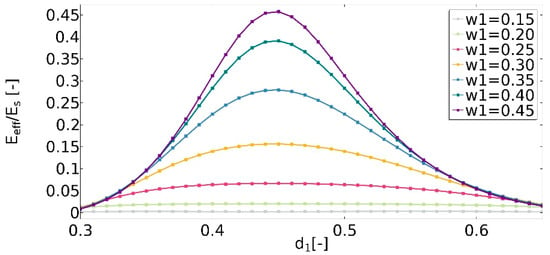
Figure 15.
The influence of geometric features on the value of the ratio of the effective Young’s modulus to Young’s modulus of structure.
Another geometric feature that influenced the obtained effective properties of the structure was the value of the radius of the fillets (Figure 16, Figure 17 and Figure 18). For the range of d1 parameters in which the structures were auxetic, the fillet had a significant impact on the resulting value of υeff. The larger the radius, the less auxetic the structure. In all analyzed cases, it was observed that the higher the value of υeff, the smaller the influence of the fillet radius.

Figure 16.
The influence of fillet radius on the value of effective Poisson’s ratio for w1 = 0.35.
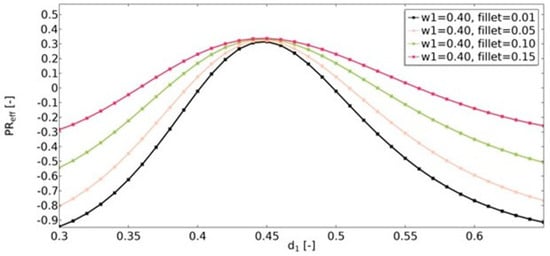
Figure 17.
The influence of fillet radius on the value of effective Poisson’s ratio for w1 = 0.40.
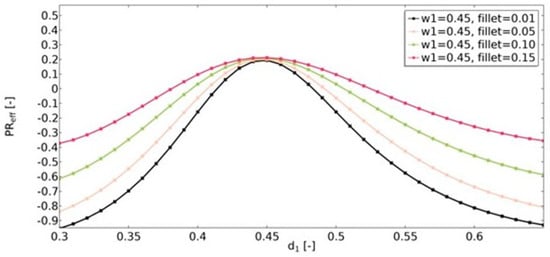
Figure 18.
The influence of fillet radius on the value of effective Poisson’s ratio for w1 = 0.45.
4.2. Mechanical Impedance
In this research, a study of the influence of geometric features of the analyzed structure on the dynamic characteristic was conducted. The frequency of the applied harmonic load changes in the range of 50–20,200 Hz (step 1 Hz) for mechanical impedance analysis and in the range of 50–5050 Hz (step 0.5 Hz) for the remaining cases.
Mechanical impedance (Equation (20)) is defined as the frequency-dependent relationship between the applied harmonic load and the velocity of an object. The analysis of mechanical impedance was conducted in the frequency range of 1 Hz to 20,200 Hz (Figure 19 and Figure 20).
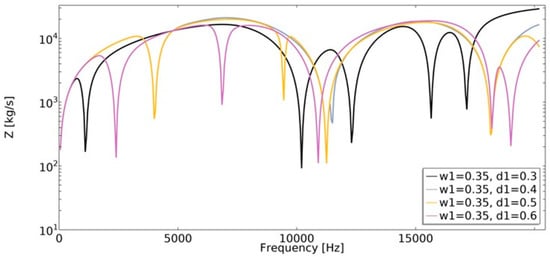
Figure 19.
The influence of geometric features on the value of mechanical impedance in the frequency range of 1–20,200 Hz for w1 = 0.35.
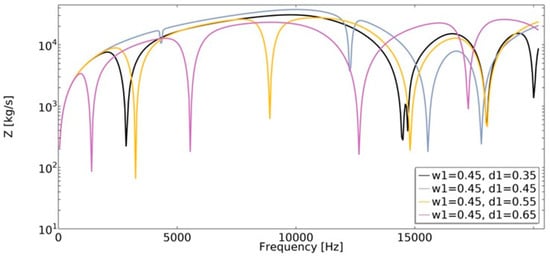
Figure 20.
The influence of geometric features on the value of mechanical impedance in the frequency range of 1–20,200 Hz for w1 = 0.45.
The lower the value of mechanical impedance, the lower the force magnitude applied in order to cause motion at a specific velocity. The obtained value of mechanical impedance strongly depends on the frequency. The changes in the geometric parameters of the structure cause significant changes in mechanical impedance values. In the frequency range of 1–20,200 Hz, the dynamic behavior strongly depends on the parametric features of the structure, which makes them auxetic or non-auxetic. The frequencies in which the minimum value of Z was achieved changed, as well as the number of local minimums of the function.
One of the obtained auxetic structures (w1 = 0.45 and d1 = 0.3) had a wider frequency gap band than other structures for frequencies in the range 1–10,000 Hz, as shown in Figure 11. Another auxetic structure (w1 = 0.35, d1 = 0.3), for the frequency above 17,000 Hz, demonstrated the most advantageous influence on the obtained dynamic characteristic. The value of mechanical impedance fluctuated in the range of 102 to 104 . For the whole analyzed range of d1 parameter, the larger the radius of the fillet, the higher the frequency value in which the local minimum is observed (Figure 21).
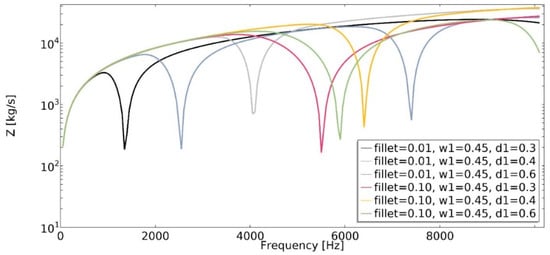
Figure 21.
The influence of fillet radius on the value of mechanical impedance in the frequency range of 1–10,100 Hz.
4.3. Vibration Transmission Loss (VTL)
Vibration transmission loss (Equation (22)) of the structures was investigated using the finite element method. The vibration transmission loss of auxetic structures reaches a higher value than structures with a positive value of the effective Poisson’s ratio (Figure 22 and Figure 23). The lowest value of VTL was achieved in a non-auxetic structure for which the variable d1 was 0.45 (for both cases of w1). With a higher value of w1, the obtained VTL reached a more beneficial level.
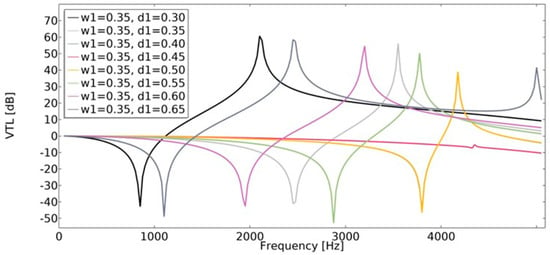
Figure 22.
The influence of geometric features on the value of VTL for w1 = 0.35.
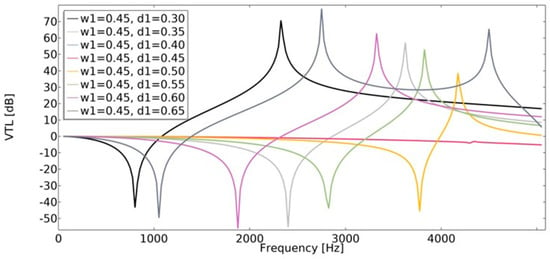
Figure 23.
The influence of geometric features on the value of VTL for w1 = 0.45.
4.4. Transmissibility
Displacement transmissibility was applied in order to assess the vibration transmission at different frequencies. This characteristic is widely used in the area of vibration isolator design. Transmissibility (Equation (21)) was studied in the range of 1–5050 Hz. The least beneficial effect on transmissibility was observed for non-auxetic structures (w1 = 0.45, d1 = 0.45), as shown in Figure 24 and Figure 25. In the case of auxetic structures, the applied displacement was significantly extinguished.
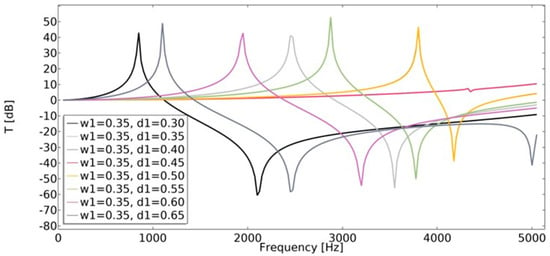
Figure 24.
The influence of geometric features on the value of transmissibility in vertical direction for w1 = 0.35.
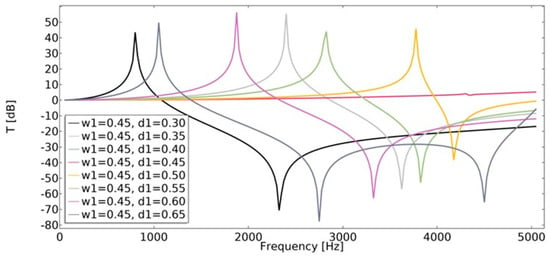
Figure 25.
The influence of geometric features on the value of transmissibility in vertical direction for w1 = 0.45.
5. Conclusions
The influence of geometric features on the obtained dynamic characteristic of the structure was evaluated. The dynamic properties of the structure were determined using parameters such as mechanical impedance (Z), vibration transmission loss (VTL), and transmissibility (T). The effective properties of an auxetic structure with rotating squares with holes were calculated as functions of geometric parameters of structures, as well.
The conducted analysis showed that the geometric parameters of the unit cell significantly affect the obtained effective properties of the structure. The achieved value of υeff for various parameter sets was in the range of −1 to 1. The smaller the dimension of the cut-out inner square, the lower the value of υeff observed. This parameter strongly whether the structure is auxetic. The dimensions of the edges of the cut-out rectangle (d1 and d2) cause changes in the value of υeff in the range of 0.43 (for w1 = 0.15) to 1.61 (for w1 = 0.3). The geometric features also significantly influence the value of Eeff.
Another analyzed parameter was the fillet radius. For non-auxetic structures, the fillet radius is not considered a significant parameter affecting the obtained value of υeff. In the case of an auxetic structure, the larger the radius, the higher the value of υeff observed.
Mechanical impedance defines the relation between the driving force at the input to a body and the resultant velocity of the body. The value of mechanical impedance is strongly dependent on frequency. The dynamic behavior could be enhanced by adjusting the geometric parameter of the structure. Auxetic structures demonstrate a higher value of vibration transmission loss than non-auxetic unit cells. The usage of structures with a negative value of Poisson’s ratio causes the applied displacement to be significantly extinguished.
The dynamic characteristic of modified rotating square structures is strongly dependent not only on frequency. It is also influenced by the applied geometric features of the structure. Adjusting the appropriate set of geometric parameters to the selected application could significantly improve the efficiency of the used structure.
Author Contributions
Conceptualization: T.S.; methodology: A.M., T.S.; software: A.M., T.S.; computation and validation: A.M. and T.S.; formal analysis: T.S.; investigation: A.M. and T.S.; resources, T.S; writing—original draft preparation: A.M., T.S.; writing—review and editing: A.M., T.S.; visualization: A.M.; supervision: T.S.; project administration: T.S.; funding acquisition: A.M., T.S. Percentage contributions: A.M. (50%), T.S. (50%). All authors have read and agreed to the published version of the manuscript.
Funding
This work has been supported by a grant from the Ministry of Education and Science in Poland: 0612/SBAD/3576 (2021), 0612/SBAD/3588 (2022) and 0612/SBAD/3589 (2022). The simulations have been made at the Institute of Applied Mechanics, Poznan University of Technology.
Data Availability Statement
Some or all data, models, or code that support the findings of this study are available from the corresponding author upon reasonable request.
Conflicts of Interest
The authors declare no conflict of interest.
References
- Lakes; Roderic, S. Composites and Metamaterials; University of Wisconsin-Madison: Madison, WI, USA; World Scientific: Hackensack, NJ, USA, 2020. [Google Scholar]
- Lim, T.C. Auxetic Materials and Structures; Springer Science+Business Media: Singapore, 2015. [Google Scholar]
- Greaves, G.N. Poisson’s ratio over two centuries: Challenging hypotheses. Notes Rec. R. Soc. J. Hist. Sci. 2012, 67, 37–58. [Google Scholar] [CrossRef] [PubMed]
- Marqués, R.; Martín, F.; Sorolla, M. Metamaterials with Negative Parameters; John Wiley & Sons, Inc.: Hoboken, NJ, USA, 2008. [Google Scholar]
- Evans, K.E.; Nkansah, M.A.; Hutchinson, I.J.; Rogers, S.C. Molecular network design. Nature 1991, 353, 124. [Google Scholar] [CrossRef]
- Lim, T.-C. Mechanics of Metamaterials with Negative Parameters; Springer Nature Singapore Pte Ltd.: Singapore, 2020. [Google Scholar] [CrossRef]
- Mir, M.; Ali, M.N.; Sami, J.; Ansari, U. Review of Mechanics and Applications of Auxetic Structures. Adv. Mater. Sci. Eng. 2014, 2014, 753496. [Google Scholar] [CrossRef]
- Novak, N.; Vesenjak, M.; Ren, Z. Auxetic Cellular Materials—A Review. Stroj. Vestn.-J. Mech. Eng. 2016, 62, 485–493. [Google Scholar] [CrossRef]
- Saxena, K.K.; Das, R.; Calius, E. Three Decades of Auxetics Research − Materials with Negative Poisson’s Ratio: A Review. Adv. Eng. Mater. 2016, 18, 1847–1870. [Google Scholar] [CrossRef]
- Kolken, H.M.A.; Zadpoor, A.A. Auxetic mechanical metamaterials. RSC Adv. 2017, 7, 5111–5129. [Google Scholar] [CrossRef]
- Duncan, O.; Shepherd, T.; Moroney, C.; Foster, L.; Venkatraman, P.D.; Winwood, K.; Allen, T.; Alderson, A. Re-view of Auxetic Materials for Sports Applications: Expanding Options in Comfort and Protection. Appl. Sci. 2018, 8, 941. [Google Scholar] [CrossRef]
- Ren, X.; Das, R.; Tran, P.; Ngo, T.D.; Xie, Y.M. Auxetic metamaterials and structures: A review. Smart Mater. Struct. 2018, 27, 023001. [Google Scholar] [CrossRef]
- Kelkar, P.U.; Kim, H.S.; Cho, K.-H.; Kwak, J.Y.; Kang, C.-Y.; Song, H.-C. Cellular Auxetic Structures for Mechanical Metamaterials: A Review. Sensors 2020, 20, 3132. [Google Scholar] [CrossRef]
- Grima-Cornish, J.N.; Attard, D.; Grima, J.N.; Evans, K.E. Auxetic Behavior and Other Negative Thermomechanical Properties from Rotating Rigid Units. Phys. Status Solidi RRL 2022, 16, 2100322. [Google Scholar] [CrossRef]
- Bilski, M.; Pigłowski, P.; Wojciechowski, K. Extreme Poisson’s Ratios of Honeycomb, Re-Entrant, and Zig-Zag Crystals of Binary Hard Discs. Symmetry 2021, 13, 1127. [Google Scholar] [CrossRef]
- Bilski, M.; Wojciechowski, K.W.; Strek, T.; Kedziora, P.; Grima-Cornish, J.N.; Dudek, M.R. Extremely Non-Auxetic Behavior of a Typical Auxetic Microstructure Due to Its Material Properties. Materials 2021, 14, 7837. [Google Scholar] [CrossRef] [PubMed]
- Novak, N.; Starčevič, L.; Vesenjak, M.; Ren, Z. Blast response study of the sandwich composite panels with 3D chiral auxetic core. Compos. Struct. 2018, 210, 167–178. [Google Scholar] [CrossRef]
- Novak, N.; Vesenjak, M.; Kennedy, G.; Thadhani, N.; Ren, Z. Response of Chiral Auxetic Composite Sandwich Panel to Fragment Simulating Projectile Impact. Phys. Status Solidi 2019, 257, 1900099. [Google Scholar] [CrossRef]
- Novak, N.; Nowak, M.; Vesenjak, M.; Ren, Z. Structural Optimization of the Novel 3D Graded Axisymmetric Chiral Auxetic Structure. Phys. Status Solidi 2022, 2200409. [Google Scholar] [CrossRef]
- Lim, T.C. A perfect 2D auxetic sliding mechanism based on an Islamic geometric pattern. Eng. Res. Express 2021, 3, 015025. [Google Scholar] [CrossRef]
- Strek, T.; Jopek, H.; Nienartowicz, M. Dynamic response of sandwich panels with auxetic cores. Phys. Status Solidi 2015, 252, 1540–1550. [Google Scholar] [CrossRef]
- Strek, T.; Matuszewska, A.; Jopek, H. Finite Element Analysis of the Influence of the Covering Auxetic Layer of Plate on the Contact Pressure. Phys. Status Solidi 2017, 254, 1700103. [Google Scholar] [CrossRef]
- Strek, T.; Michalski, J.; Jopek, H. Computational analysis of the mechanical impedance of the sandwich beam with auxetic metal foam core. Phys. Status Solidi B 2019, 256, 1800423. [Google Scholar] [CrossRef]
- Shepherd, T.; Winwood, K.; Venkatraman, P.; Alderson, A.; Allen, T. Validation of a Finite Element Modeling Process for Auxetic Structures under Impact. Phys. Status Solidi B 2020, 257, 1900197. [Google Scholar] [CrossRef]
- Jopek, H.; Strek, T. Thermal and structural dependence of auxetic properties of composite materials. Phys. Status Solidi 2015, 252, 1551–1558. [Google Scholar] [CrossRef]
- Jopek, H.; Strek, T. Thermoauxetic Behavior of Composite Structures. Materials 2018, 11, 294. [Google Scholar] [CrossRef] [PubMed]
- Michalski, J.; Strek, T. Fatigue Life of Auxetic Re-entrant Honeycomb Structure. In Advances in Manufacturing II. Lecture Notes in Mechanical Engineering; Gapiński, B., Szostak, M., Ivanov, V., Eds.; Springer: Cham, Switzerland, 2019; pp. 50–60. [Google Scholar]
- Michalski, J.; Strek, T. Blast resistance of sandwich plate with auxetic anti-tetrachiral core. Vib. Phys. Syst. 2020, 31, 2020317. [Google Scholar]
- Michalski, J.; Strek, T. Response of a Sandwich Plate with Auxetic Anti-tetrachiral Core to Puncture. In Advances in Manufacturing III. MANUFACTURING 2022. Lecture Notes in Mechanical Engineering; Gapiński, B., Ciszak, O., Ivanov, V., Eds.; Springer: Cham, Switzerland, 2022; pp. 1–18. [Google Scholar]
- Burlaga, B.; Strek, T. The vibrations induced by fluid flow in plates with different Poisson’s ratios. Vib. Phys. Syst. 2020, 31, 2020301. [Google Scholar]
- Zhang, Q.; Yu, X.; Scarpa, F.; Barton, D.; Zhu, Y.; Lang, Z.; Zhang, D. A dynamic poroelastic model for auxetic polyurethane foams involving viscoelasticity and pneumatic damping effects in the linear regime. Mech. Syst. Signal Process. 2022, 179, 109375. [Google Scholar] [CrossRef]
- Lim, T.C. Analogies across auxetic models based on deformation mechanism. Phys. Status Solidi RRL 2017, 11, 1600440. [Google Scholar] [CrossRef]
- Grima, J.N.; Evans, K.E. Auxetic behavior from rotating squares. J. Mater. Sci. Lett. 2000, 19, 1563–1565. [Google Scholar] [CrossRef]
- Grima, J.N.; Alderson, A.; Evans, K.E. Negative Poisson’s Ratios From Rotating Rectangles. Comput. Methods Sci. Technol. 2004, 10, 137–145. [Google Scholar] [CrossRef]
- Grima, J.N.; Alderson, A.; Evans, K.E. Auxetic behaviour from rotating rigid units. Phys. Stat. Sol. 2005, 242, 561–575. [Google Scholar] [CrossRef]
- Grima, J.N.; Zammit, V.; Gatt, R.; Alderson, A.; Evans, K.E. Auxetic behaviour from rotating semi-rigid units. Phys. Status Solidi B 2007, 244, 866–882. [Google Scholar] [CrossRef]
- Grima, J.N.; Farrugia, P.S.; Gatt, R.; Attard, D. On the auxetic properties of rotating rhombi and parallelograms: A preliminary investigation. Phys. Status Solidi B 2008, 245, 521–529. [Google Scholar] [CrossRef]
- Dubrovski, P.D.; Novak, N.; Borovinšek, M.; Vesenjak, M.; Ren, Z. In-Plane Deformation Behavior and the Open Area of Rotating Squares in an Auxetic Compound Fabric. Polymers 2022, 14, 571. [Google Scholar] [CrossRef] [PubMed]
- Han, D.; Ren, X.; Zhang, Y.; Zhang, X.Y.; Zhang, X.G.; Luo, C.; Xie, Y.M. Lightweight auxetic metamaterials: Design and characteristic study. Compos. Struct. 2022, 293, 115706. [Google Scholar] [CrossRef]
- Strek, T.; Kedziora, P.; Maruszewski, B.; Pozniak, A.; Tretiakov, K.V.; Wojciechowski, K.W. Finite element analysis of auxetic obstacle deformation and fluid flow in a channel. J. Non-Cryst. Solids 2009, 355, 1387–1392. [Google Scholar] [CrossRef]
- Carneiro, V.H.; Meireles, J.; Puga, H. Auxetic Materials—A Review. Mater. Sci.-Pol. 2013, 31, 561–571. [Google Scholar] [CrossRef]
- Prawoto, Y. Seeing auxetic materials from the mechanics point of view: A structural review on the negative Poisson’s ratio. Comput. Mater. Sci. 2012, 58, 140–153. [Google Scholar] [CrossRef]
- Duncan, O. Auxetic Foams for Sports Applications. Ph.D. Thesis, Sheffield Hallam University, Sheffield, UK, 2019. [Google Scholar]
- Proffit, M.; Kennedy, J. Dynamic response of auxetic structures. Vibroengineering PROCEDIA 2020, 31, 1–6. [Google Scholar] [CrossRef]
- Fuguang, R.; Wang, L.; Liu, H. Low frequency and broadband vibration attenuation of a novel lightweight bidirectional re-entrant lattice metamaterial. Mater. Lett. 2021, 299, 130133. [Google Scholar]
- Tao, Z.; Ren, X.; Zhao, A.G.; Sun, L.; Zhang, Y.; Jiang, W.; Han, D.; Zhang, X.Y.; Xie, Y.M. A novel auxetic acoustic metamaterial plate with tunable bandgap. Int. J. Mech. Sci. 2022, 226, 107414. [Google Scholar] [CrossRef]
- Yu, Y.; Zhang, Z.; Bi, Q. Multistability and fast-slow analysis for van der Pol–Duffing oscillator with varying exponential delay feedback factor. Appl. Math. Model. 2018, 57, 448–458. [Google Scholar] [CrossRef]
- Yu, Y.; Zhang, Z.; Han, X. Periodic or chaotic bursting dynamics via delayed pitchfork bifurcation in a slow-varying controlled system. Commun Nonlinear Sci. Numer. Simulat. 2018, 56, 380–391. [Google Scholar] [CrossRef]
- Bhullar, S.K.; Mawanane Hewage, A.T.; Alderson, A.; Alderson, K.; Jun, M.B.G. Influence of Negative Poisson’s Ratio on Stent Applications. Adv. Mater. 2013, 2, 42–47. [Google Scholar] [CrossRef]
- Bhullar, S.K.; Ko, J.; Ahmed, F.; Ju, M.B.G. Design and Fabrication of Stent with Negative Poisson’s Ratio. World Academy of Science. Engineering and Technology. Int. J. Mech. Aerosp. Ind. Mechatron. Eng. 2014, 8, 462–468. [Google Scholar]
- Gatt, R.; Mizzi, L.; Azzopardi, J.I.; Azzopardi, K.M.; Attard, D.; Casha, A.; Grima, J.N. Hierarchical Auxetic Mechanical Metamaterials. Sci. Rep. 2015, 5, 8395. [Google Scholar] [CrossRef] [PubMed]
- Khoshgoftar, M.J.; Barkhordari, A.; Limuti, M.; Buccino, F.; Vergani, L.; Mirzaali, M.J. Bending analysis of sandwich panel composite with a re-entrant lattice core using zig-zag theory. Sci. Rep. 2022, 12, 15796. [Google Scholar] [CrossRef]
- Documentation of COMSOL Multiphysics Software. In Structural Mechanics Module User’s Guide; COMSOL: Stockholm, Sweden, 2015.
- Bower, A.F. Applied Mechanics of Solids; Taylor and Francis Group, LLC: Boca Raton, FL, USA, 2010. [Google Scholar]
- Zi-Xing, L.; Qiang, L.; Zhen-Yu, Y. Predictions of Young’s modulus and negative Poisson’s ratio of auxetic foams. Phys. Status Solidi B 2011, 248, 167–174. [Google Scholar]
- On, F.J. Mechanical Impedance Analysis For Lumped Parameter Multi-Degree of Freedom. In Multi-Dimensional Systems; NASA: Washington, DC, USA, 1967. [Google Scholar]
- Gatti, P.L.; Ferrari, V. Applied Structural and Mechanical Vibrations; CRC Press Taylor & Francis Group: New York, NY, USA, 2014. [Google Scholar]
- Song, Y.; Sun, X. Modeling and Dynamics of a MDOF Isolation System. Appl. Sci. 2017, 7, 393. [Google Scholar] [CrossRef]
- Thamburaj, P.; Sun, J.Q. Effect of Material and Geometry on the Sound and Vibration Transmission across a Sandwich Beam. J. Vib. Acoust. 2001, 123, 205–212. [Google Scholar] [CrossRef]
- Idczak, E.; Stręk, T. Computational Modelling of Vibrations Transmission Loss of Auxetic Lattice Structure. Vib. Phys. Syst. 2016, 27, 123–128. [Google Scholar]
- Zienkiewicz, O.C.; Taylor, R.L. The Finite Element Method, 5th ed.; Butterworth-Heinemann: Oxford, UK, 2000; Volumes 1–3. [Google Scholar]
Publisher’s Note: MDPI stays neutral with regard to jurisdictional claims in published maps and institutional affiliations. |
© 2022 by the authors. Licensee MDPI, Basel, Switzerland. This article is an open access article distributed under the terms and conditions of the Creative Commons Attribution (CC BY) license (https://creativecommons.org/licenses/by/4.0/).